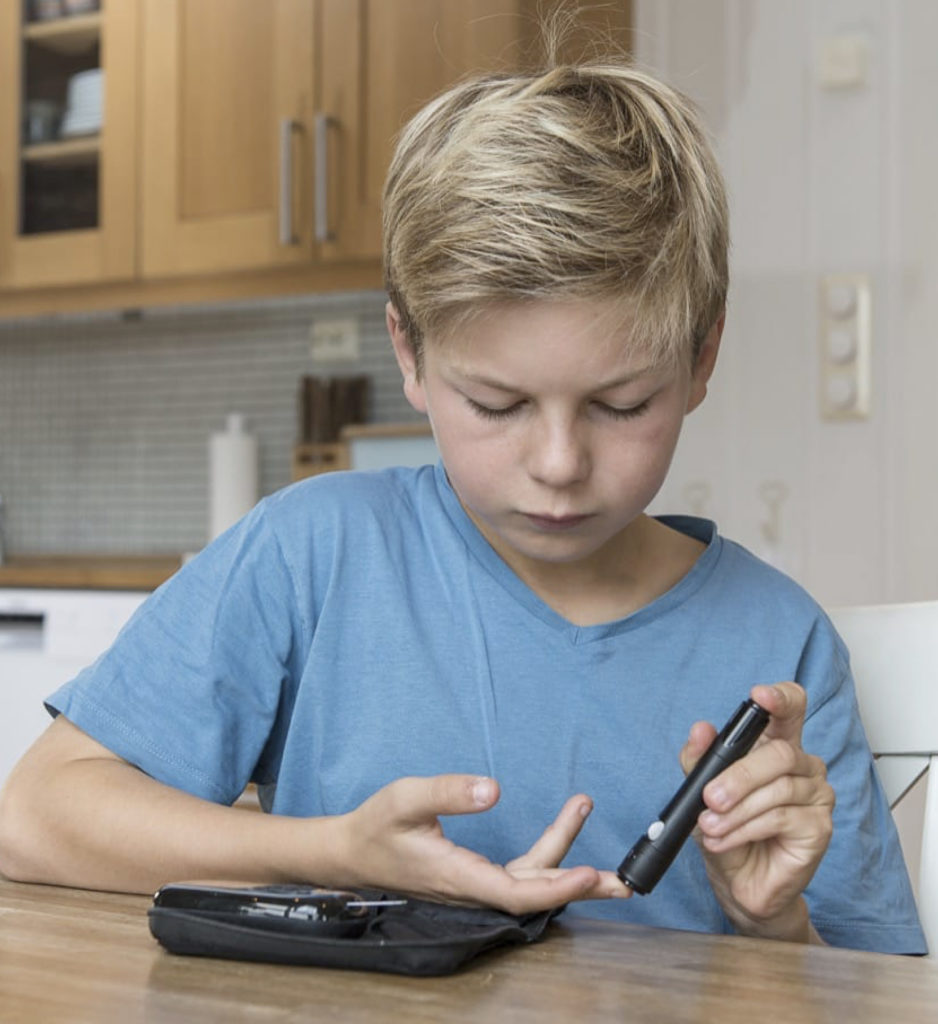Children are increasingly at risk of getting diabetes
Factors such as obesity, sedentary lifestyles, and diet are increasing type 2 diabetes in children
By: Diana Bello Aristizábal
DORAL, FL – November is National Diabetes Month, a time to fight against this disease. In this fight, which is justified by the alarming statistics of the American Diabetes Association, children are also included now, due to their increasing risk of getting diabetes type 2.
According to the American Diabetes Association, 1.25 million Americans suffer from type 1 diabetes, and 40,000 more will be diagnosed this year. However, type 2 diabetes is growing alarmingly due to the high rates of obesity in the population.

“Forty years ago, I used to see two cases annually of pediatric diabetes type 2. Now I see two per week, and it is believed that the main risk factor is obesity,” says Dr. Marco Danon, pediatric endocrinologist, who works in multiple hospitals in the area, including Baptist Hospital of Miami and Nicklaus Children’s Hospital.
According to the expert, 16 percent of children in the United States are obese, and all of them are at risk of developing diabetes, although only 2 to 3 percent annually become diabetics.
A similar perception has Maria Gomez-Borgo, a certified diabetes educator and registered and licensed dietitian from Kendall Regional Medical Center for whom type 2 diabetes is the most common one in children.
“Type 2 diabetes mellitus, which was once considered a rare condition in the pediatric population, now account for about 15% to 45% of all newly diagnosed cases of diabetes in children. Until 10 years ago, type 2 diabetes accounted for less than 3% of all cases of new-onset diabetes in adolescents,” says Gomez-Borgo.
This means that currently, all eyes are focused on the prevention of type 2 diabetes, the only one that can be controlled through a healthy lifestyle that includes physical activity and a balanced diet.
In this regard, it should be clarified that although the two types of diabetes imply high blood sugar, each one develops differently. Type 1 originates when there is a lack of insulin, while type 2 is suffered by those who develop resistance to insulin.
 On the other hand, type 1 diabetes has an important genetic component that can be activated in certain environmental conditions and can only be treated with insulin.
On the other hand, type 1 diabetes has an important genetic component that can be activated in certain environmental conditions and can only be treated with insulin.
Meanwhile, type 2 appears due to a lack of action in insulin that is present in the body but does not work properly because of excess weight.
“All Latinos have a genetic predisposition to develop type 2 diabetes because of the way our ancestors stored fat in their bodies, and we are currently the second world group with the highest incidence of diabetes,” warns Gomez-Borgo.
However, this type of diabetes is only activated when certain environmental conditions come into place (poor diet combined with inactivity). This means that contrary to type 1, which is insulin-dependent, type 2 depends exclusively on the patient’s cooperation to lose weight.
“Family needs to cooperate a lot to control obesity, but if the patient manages to lose weight with physical activity and proper nutrition, diabetes can disappear,” adds Dr. Danon.
Doctor visit, diagnosis, and treatment
In addition to obesity as a warning signal for type 2 diabetes, there are some symptoms that may indicate the presence of the disease in either type. These are mainly excessive thirst and increased urination frequency.
“Children who have diabetes often wet their beds when they are already potty trained or get up from bed several times at night to pee,” says Dr. Danon.
When these symptoms appear, it is recommended to visit a pediatrician who, according to weight and size charts, will determine if there is an excess of caloric intake and whether or not it is convenient to refer the patient to a pediatric endocrinologist.
The diagnosis will only be made after the patient is subjected to a test in which it will be verified if the blood sugar levels are normal or not. “Currently, parents of young children are very attentive to any showed symptoms and take them to the doctor in a timely manner,” says Dr. Danon.
However, complications in the adolescent population often occur, as well as late diagnosis, mainly because parents are less aware of symptoms or warning signs. Therefore, the recommendation is to monitor eating habits, physical activity patterns, and symptoms associated with diabetes in children of all ages.
After a diabetes diagnosis is made, the next step is to set up a treatment that for type 1 consists of getting insulin several times a day according to what is eaten and measuring blood sugar levels.
“Currently, we have insulin pumps that make the process easier and control insulin perfectly. Everything is done through interconnected systems that measure blood sugar and provide insulin. Patients no longer endure the “torturing” procedures of past decades,” explains Dr. Danon.
For the reasons mentioned above, today management of type 1 diabetes is considered much simpler than that of type 2, since once parents and caregivers learn the basics, children can lead a normal life.
“A child with this diagnosis can eat anything as long as insulin is adjusted to the amount of carbohydrates eaten. If the patient is not overweight, as it is the case with most, he or she can take carbohydrates in small portions, although this recommendation applies to everyone, ”says María Gomez-Borgo.
With diabetes type 2, it is required more dedication from the family that must follow a low-carb diet and engage in a physical activity routine in order to help the patient reduce body weight.
“To cope with this diagnosis, the family must do a joint effort and, unfortunately, in many cases, parents have two jobs and lack time to monitor their children’s food,” says Dr. Danon.
Education and nutrition
Due to the fact that receiving a diagnosis of diabetes, regardless of the type, is not easy for any family, the success of the treatment, in many cases, depends on the level of education that parents have about the disease and the commitment to the food plan.
“The educational component is very important because what works with one patient may fail with another, which is why my task as an educator is to make sure the individual needs of each patient are covered, ”explains Mónica Grimaldi, a registered dietitian and certified diabetes educator at Nicklaus Children’s Hospital.
Taking this in regard, it is advisable to look for the advice of an educator and a registered dietitian, who are prepared to teach families important aspects of the disease, such as the correct way to count calories or how to include diabetes within the family routine.
 “Diabetes requires families to be united in the sense that there is a greater chance of success when the whole family is involved. The first step towards that direction is to establish a schedule for the disease using tools, such as mobile notifications or alarms,” recommends the specialist.
“Diabetes requires families to be united in the sense that there is a greater chance of success when the whole family is involved. The first step towards that direction is to establish a schedule for the disease using tools, such as mobile notifications or alarms,” recommends the specialist.
Maria Gomez-Borgo has a similar opinion regarding family involvement. She states that a child cannot be asked to follow a healthy diet when the rest of the family does not adhere to the regime.
“Food requirements are for the whole family. The problem with Latinos is that they take too many carbohydrates with each meal, just as they used to in their countries of origin. The difference is that here in the U.S., they don’t get physically active because they get carried away by the American way of life, ”explains the expert.
And what are usually food requirements? According to Gomez-Borgo, it’s about taking small portions trying to make 90 percent of the diet healthy and the remaining 10 percent, “food for the soul.”
“Feed your family as you would a 3-year-old child; include fruits, vegetables, protein and fat on your plate and carbohydrate portions the size of your clenched fist,” says Gomez-Borgo.
But in addition to this, the key is also to eliminate some bad habits that can impact the weight of children. “If you only cut out sugary drinks, it is possible to lose 12 pounds a year,” she explains.
And it is not necessary to follow a restrictive or frustrating diet for children but rather teach them self-control without banning any food. This means that it is valid to let them eat Halloween candies or birthday cakes as long as parents can monitor and distribute portions.
“You can save the birthday cake for later and offer it at home little by little without telling them, “you can’t eat that” or “how many times have I told you that you have diabetes?”
Instead, the expert suggests following a more balanced approach in which children are taught to eat properly, including exercise as the most effective ingredient to fight diabetes.


Interesting article! I really enjoyed it and it reminded me how I could reverse type 2 diabetes and lose weight. Actually, I felt lost a long time ago, but looking online I found something that really helped me to reverse the disease and also to lose weight. For those who also feel lost, you can see the information here, I hope it helps someone.
click here>> linktr.ee/Halki.Diabetes.Remedy
After my DIABETES TYPE 2 diagnosis, I had typical symptoms of thirst, lethargy, severe tiredness, urinary frequency, hearing loss and ringing in the ears, vision problems, dehydration and weight gain. I was placed on metformin twice daily for several months, the symptoms only seemed to worsened. I began to do a lot of research and learnt about a DIABETES HERBAL TREATMENT from Rich Herbal Garden and their success rate with the Diabetes treatment, i immediately started on the treatment, i started experience decline in major symptoms, the severe thirst, dry mouth, tiredness, urinary problems, dehydration and fatigue. My doctor took me off the metformin and other medications i was placed after the diabetes herbal treatment. Visit rich heral gardens ww w. richherbalgardens. c om . I did another blood test after the treatment, i am diabetes free. I have also lost over 35 pounds since treatment.
Hey Diana, thanks for sharing such an informative post. These days diabetes risk ib children are increasing at a fast pace. Proper nutrition and diet must be provided to children. As it will keep them away with such risk and they can lead a healthy life.
Hi. Thank you for sharing your experience.
Hi Johnny. I’m glad you found the article informative. And yes, diet it’s a very important part of children’s diabetes recovery.
Hi. Thanks for sharing. Stay healthy.
Pingback: What Are The Educational Requirements For A Dietitian | News: Breaking stories & updates